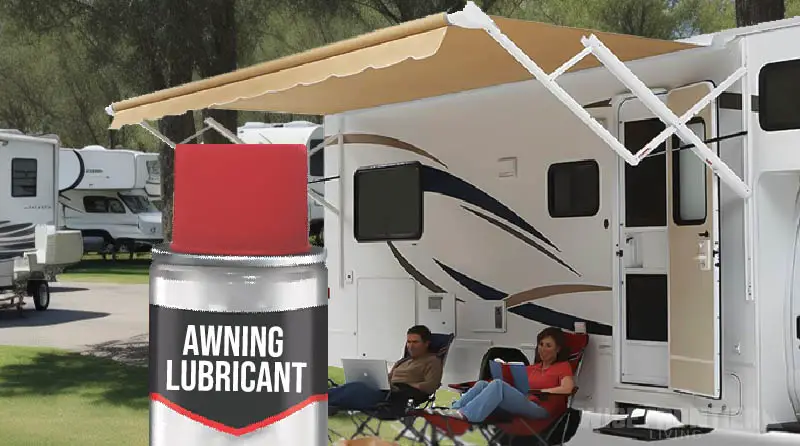RVing has become increasingly popular as people look for ways to enjoy the great outdoors, travel, and live on the go. One essential feature in many RVs is the awning, which provides shade, protection, and comfort. However, proper maintenance is crucial to keep the awning working smoothly and efficiently.
One of the critical steps in this maintenance process is lubrication. In most cases, lubrication is seldom needed, but generally speaking, moving parts should be lubricated occasionally to keep them in working order.
Key Takeaway:
Using 3-in-1 Lock Dry Lube is an effective and convenient solution to safeguard your RV awning. This lubricant prevents friction and wear on moving parts and protects against moisture and corrosion. By applying 3-in-1 Lock Dry Lube to the hinges, joints, and extending mechanisms of your awning, you ensure its smooth operation, extend its lifespan, enhance durability, and shield it from the damaging effects of the elements.
Why Lubricate Your RV Awning?
Awnings can get stuck or become hard to retract and extend due to various reasons, such as:
- Dirt, dust, and grime build-up
- Corrosion from exposure to the elements
- Frequent use causing wear and tear
Regular lubrication can mitigate these problems, making the awning mechanism operate smoothly and extending its lifespan.
Your geographical location will also play a part in the longevity of your awning. Dry, dusty, wet, and humid climates will impact your awning.
Choosing the Best Lubricant for RV Awnings
When selecting a lubricant, there are several factors to consider:
- Water Resistance: RVs are exposed to different weather conditions. A water-resistant lubricant ensures that rain or moisture doesn’t wash it away quickly.
- Dirt and Dust Resistance: Since RVs travel through various environments, it’s essential that the lubricant doesn’t attract or hold onto dirt and dust.
- Temperature Stability: The lubricant should work efficiently in both high and low temperatures.
- Non-Staining: As awnings are often fabric-based, you wouldn’t want a lubricant that leaves behind unsightly stains.
Given these considerations, here are some of the best lubricants for RV awnings:
- Silicone-based sprays: Silicone lubricants are often favored for awnings as they’re water-resistant and won’t attract dirt. They form a thin, slick layer which can help to protect metal parts from corrosion. Moreover, they do not usually stain fabrics.
- Dry lubricants: These contain Teflon or PTFE, which can provide a smooth operation without attracting dirt or dust. They are especially useful in environments where the awning is exposed to a lot of sand or fine particles. CRC Power Lube High-Performance Lubricants With PTFE
- Graphite lubricants: Ideal for lock mechanisms, they can also be useful for some awning components that require a dry lubrication solution. CRC Dry Graphite Lube
Application Tips:
- Always clean the awning mechanism thoroughly before applying any lubricant. Removing dirt and grime will ensure the lubricant works effectively.
- Avoid over-applying. A thin, even coat is generally sufficient.
- For hard-to-reach areas, consider using a lubricant with a straw nozzle.
- Always test a small area first, especially if you’re concerned about potential staining on the fabric or surrounding areas.
Dry lubricants vs. wet lubricants for awning
Dry Lubricants:
Advantages:
- No Mess: Dry lubricants, as the name suggests, don’t attract dirt or dust like wet lubricants do. This means they are less likely to create a sticky residue that can accumulate grime over time.
- Clean Application: Applying a dry lubricant is generally cleaner and easier. Dry lubricants usually come in a spray or powder form, making them simple to apply precisely to the intended areas.
- Less Attraction to Debris: Since dry lubricants don’t create a wet surface, they are less likely to attract debris, making them suitable for areas where cleanliness is a concern.
- Weather Resistance: Dry lubricants often provide better resistance to water and moisture, which can be particularly beneficial for outdoor applications like RV awnings.
Disadvantages:
- Shorter Lasting: Dry lubricants tend to have a shorter lifespan compared to wet lubricants, meaning you might need to reapply them more frequently.
- Less Viscosity: Dry lubricants might have a thinner consistency compared to wet lubricants, which could affect their longevity in extreme conditions.
Wet Lubricants:
Advantages:
- Longer Lasting: Wet lubricants, usually oil-based, tend to provide longer-lasting lubrication and protection due to their thicker and more viscous nature.
- Penetration: Wet lubricants can penetrate deeper into moving parts, providing better coverage and protection for hinges, joints, and other components.
- Initial Lubrication: Wet lubricants often offer superior initial lubrication upon application, which can be beneficial if your awning hasn’t been lubricated in a while.
Disadvantages:
- Messy Application: Wet lubricants can attract dirt and dust, potentially creating a sticky mess over time. This might require more frequent cleaning and reapplication.
- Potential for Staining: Some wet lubricants might stain fabrics or materials if not applied carefully.
Choosing the Right Type for Your RV Awning:
When deciding between dry and wet lubricants for your RV awning, consider your specific needs and preferences:
- Choose Dry Lubricants If: You value cleanliness, want a more weather-resistant option, and are willing to reapply the lubricant more frequently to maintain effectiveness.
- Choose Wet Lubricants If: You prioritize longer-lasting lubrication, are comfortable with a potentially messier application, and want better initial protection for your awning’s moving parts.
Before You Leave: A Parting Gift of Wisdom!
Routine maintenance, including proper lubrication, can significantly extend the life of your RV awning and ensure it functions smoothly throughout your travels. By selecting the right lubricant and applying it correctly, you can enjoy a hassle-free RVing experience. Safe travels!
